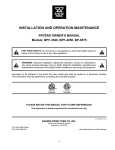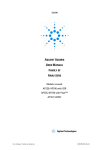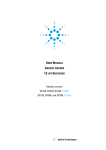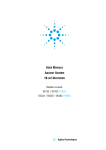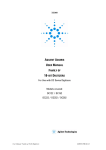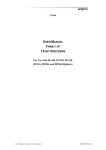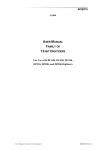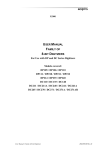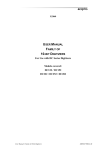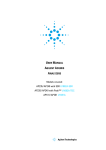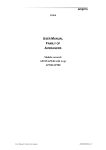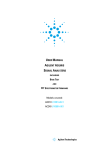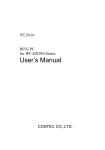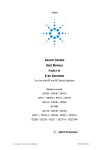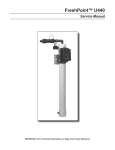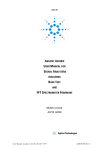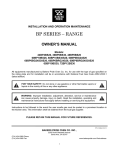Download User Manual: 12-bit Digitizers
Transcript
USER MANUAL AGILENT ACQIRIS 12-BIT DIGITIZERS Models covered: DC440, DC438, DC436 U1066A DP310, DP308, and DP306 U1070A Manual Part Number U1092-90005 Edition C-RevJ, December 2007 The information in this document is subject to change without notice and may not be construed in any way as a commitment by Agilent Technologies, Inc. While Agilent makes every effort to ensure the accuracy and contents of the document it assumes no responsibility for any errors that may appear. All software described in the document is furnished under license. The software may only be used and copied in accordance with the terms of license. Instrumentation firmware is thoroughly tested and thought to be functional but it is supplied “as is” with no warranty for specified performance. No responsibility is assumed for the use or the reliability of software, firmware or any equipment that is not supplied by Agilent or its affiliated companies. You can download the latest version of this manual from http://www.agilent.com/ by clicking on Manuals in the Technical Support section and then entering a model number. You can also visit our web site at http://www.agilent.com/find/acqiris. At Agilent we appreciate and encourage customer input. If you have a suggestion related to the content of this manual or the presentation of information, please contact your local Agilent Acqiris product line representative or the dedicated Agilent Acqiris Technical Support ([email protected]). Acqiris Product Line Information USA (845) 782-6544 Asia - Pacific 61 3 9210 2890 Europe 41 (22) 884 32 90 © Copyright Agilent 2007 User Manual: Agilent Acqiris 12-bit Digitizers Page 2 of 48 CONTENTS 1. OUT OF THE BOX........................................................................................................................... 5 1.1. Message to the User ..................................................................................................................... 5 1.2. Using this Manual ........................................................................................................................ 5 1.3. Conventions Used in This Manual............................................................................................... 5 1.4. Model Names ............................................................................................................................... 6 1.5. Disclaimer and Safety .................................................................................................................. 6 1.6. Warning Regarding Medical Use................................................................................................. 6 1.7. Packaging and Handling .............................................................................................................. 6 1.8. Warranty ...................................................................................................................................... 7 1.9. Warranty and Repair Return Procedure, Assistance and Support ................................................ 7 1.10. System Requirements................................................................................................................... 7 1.11. Transport & Shipping .................................................................................................................. 8 1.12. Maintenance................................................................................................................................. 8 1.13. Cleaning ....................................................................................................................................... 9 1.14. Disposal and Recycling................................................................................................................ 9 2. INSTALLATION ............................................................................................................................ 10 2.1. U1091AK02 IC414 Installation ................................................................................................. 10 2.1.1. IC414 Hardware installation hints.................................................................................. 10 2.1.2. IC414 Windows software installation ............................................................................ 10 2.2. Installing the Software under Windows ..................................................................................... 11 2.2.1. Warnings ........................................................................................................................ 11 2.2.2. Multiple Versions........................................................................................................... 11 2.2.3. Installation...................................................................................................................... 12 2.3. Installing the Software for Linux ............................................................................................... 12 2.3.1. Environment variables for the Firmware........................................................................ 15 2.4. Installing the Hardware.............................................................................................................. 15 2.5. After Restarting.......................................................................................................................... 16 2.5.1. Windows 2000 ............................................................................................................... 16 2.5.2. Windows XP .................................................................................................................. 16 2.6. LabVIEW RT............................................................................................................................. 17 2.7. Installing the IVI-COM/C Driver............................................................................................... 17 2.8. Distribution for Windows 2000/XP and Linux .......................................................................... 17 3. PRODUCT DESCRIPTION........................................................................................................... 18 3.1. Overview.................................................................................................................................... 18 3.2. Channel Input............................................................................................................................. 19 3.2.1. Coupling & Impedance .................................................................................................. 19 3.2.2. Input Protection.............................................................................................................. 19 3.2.3. Mezzanine Front-end...................................................................................................... 19 3.2.4. Bandwidth and Rise Time .............................................................................................. 19 3.2.5. Input Voltage and Offset ................................................................................................ 20 3.2.6. Vertical Resolution......................................................................................................... 20 3.2.7. DC Accuracy and Linearity............................................................................................ 20 3.3. Data Acquisition ........................................................................................................................ 21 3.3.1. High Resolution Sample Rate ........................................................................................ 21 3.3.2. Acquisition Memory ...................................................................................................... 22 3.3.3. Single and Sequence Acquisition Modes ....................................................................... 22 3.3.4. Timing............................................................................................................................ 23 3.3.5. Timebase Range ............................................................................................................. 23 3.3.6. Sparkle code rate ............................................................................................................ 23 3.4. Trigger ....................................................................................................................................... 23 3.4.1. Trigger Source................................................................................................................ 23 3.4.2. Trigger Coupling............................................................................................................ 23 3.4.3. Trigger Level.................................................................................................................. 24 3.4.4. Edge Trigger Slope......................................................................................................... 24 3.4.5. Pre- and Post-Trigger Delay........................................................................................... 24 3.4.6. TV Trigger ..................................................................................................................... 24 User Manual: Agilent Acqiris 12-bit Digitizers Page 3 of 48 3.4.7. Trigger Status ................................................................................................................. 24 3.5. External Clock and Reference.................................................................................................... 24 3.6. Internal Calibration .................................................................................................................... 25 3.7. AS bus........................................................................................................................................ 25 3.8. Special Front Panel Inputs and Controls .................................................................................... 26 3.9. External Trigger Output............................................................................................................. 26 3.10. Electrical, Environmental and Physical Specifications.............................................................. 27 3.10.1. Electrical ........................................................................................................................ 27 3.10.2. Environmental and Physical........................................................................................... 27 4. RUNNING THE ACQIRISLIVE APPLICATION ...................................................................... 29 4.1. Getting Started with AcqirisLive ............................................................................................... 29 4.2. Control Panel and Functions ...................................................................................................... 30 4.2.1. Control Panel Mode ....................................................................................................... 30 4.2.2. Displaying Multiple Traces............................................................................................ 31 4.2.3. Numeric Editor............................................................................................................... 32 4.2.4. Keyboard shortcuts......................................................................................................... 32 4.2.5. Input Voltage Scale, Offset and Coupling...................................................................... 33 4.2.6. Trigger............................................................................................................................ 33 4.2.7. Acquisition Mode........................................................................................................... 34 4.2.8. Timebase and Memory................................................................................................... 34 4.2.9. Using digitizers of different models simultaneously...................................................... 35 4.2.10. Segmented Memory ....................................................................................................... 35 4.2.11. Display Features, Zoom and Persistence........................................................................ 35 4.3. Top Line Menu of AcqirisLive .................................................................................................. 36 4.4. Setup .......................................................................................................................................... 36 4.5. Store, Autostore and Conversion of Waveforms ....................................................................... 36 4.6. Calibrate..................................................................................................................................... 38 4.7. External 10 MHz Reference and External Clock ....................................................................... 38 4.8. Additional Waveform Information ............................................................................................ 38 4.9. Display Features......................................................................................................................... 38 4.10. Command Line Switches ........................................................................................................... 39 5. RUNNING THE GEOMAPPER APPLICATION....................................................................... 41 5.1. Who needs a Geographical Map of Modules ............................................................................. 41 5.2. When should the GeoMapper Application be used.................................................................... 41 5.3. How to run GeoMapper ............................................................................................................. 41 6. APPENDIX A: U1056A AS BUS FOR COMPACTPCI/PXI DIGITIZERS ............................ 44 7. APPENDIX B: XA001 BATTERY BACKUP FOR COMPACTPCI DIGITIZERS ................ 45 8. APPENDIX C: U1092A-HVB XA100 BNC INPUT OVERVOLTAGE PROTECTION ......... 46 9. APPENDIX D: U1091AX01 XP100 FAN UNIT FOR THE DP DIGITIZER FAMILY........... 47 10. APPENDIX E: U1091AX03 XP103 FAN UNIT FOR THE DP FAMILY OF MODULES...... 48 User Manual: Agilent Acqiris 12-bit Digitizers Page 4 of 48 1. Out of the Box 1.1. Message to the User Congratulations on having purchased an Agilent Technologies Acqiris data conversion product. Acqiris digitizers are high-speed data acquisition modules designed for capturing high frequency electronic signals. To get the most out of the products we recommend that you read this manual carefully. We trust the product you have purchased will meet with your expectations and provide you with a high quality solution to your data conversion applications. 1.2. Using this Manual This guide assumes you are familiar with the operation of a personal computer (PC) running a Windows 2000/XP or other supported operating system. It also assumes you have a basic understanding of the principles of data acquisition using either a waveform digitizer or a digital oscilloscope. The manual is divided into 5 separate sections. To understand the elements of operation for the module it is essential that you read them all. Chapter 1 OUT OF THE BOX, describes what to do when you first receive your new Acqiris product. Special attention should be paid to sections on safety, packaging and product handling. Before installing your product please ensure that your system configuration matches or exceeds the requirements specified. Chapter 2 INSTALLATION, covers all elements of installation and performance verification. Before attempting to use your Acqiris product for actual measurements we strongly recommend that you read all sections of this chapter. Chapter 3 PRODUCT DESCRIPTION, provides a full description of all the functional elements of the digitizer. Chapter 4 RUNNING THE ACQIRISLIVE APPLICATION, describes the operation of AcqirisLive 3.2, an application that enables basic operation of Acqiris digitizers in a Windows 2000/XP environment. Note: AcqirisMAQS is an alternate software application offering many interesting possibilities for the control of acquisition systems in a single or multi-machine environment. Ask your sales representative or Agilent for more information. Chapter 5 RUNNING THE GEOMAPPER APPLICATION, describes the purpose and operation of the GeoMapper application which is needed for some AS bus Multi-instrument systems. For information necessary for writing your own software to control Acqiris products you should refer to the Programmer’s Guide and the Programmer’s Reference Manual. 1.3. Conventions Used in This Manual The following conventions are used in this manual: This icon to the left of text warns that an important point must be observed. WARNING Denotes a warning, which advises you of precautions to take to avoid being electrically shocked. CAUTION Denotes a caution, which advises you of precautions to take to avoid electrical, mechanical, or operational damages. NOTE Denotes a note, which alerts you to important information. Italic text denotes a warning, caution, or note. Bold Italic text is used to emphasize an important point in the text or a note mono text is used for sections of code, programming examples and operating system commands. User Manual: Agilent Acqiris 12-bit Digitizers Page 5 of 48 1.4. Model Names Agilent Technologies Inc. acquired Acqiris SA and its product lines in December 2006. Use the tables below to cross reference the legacy model name and new Agilent numbers Agilent Model Number U1066A U1066A U1066A U1070A U1070A U1070A 1.5. Acqiris Model Name DC436 DC438 DC440 DP306 DP308 DP310 Disclaimer and Safety The DP Series 12-bit PCI digitizer cards have been designed to operate in a standard PCI slot found inside most personal computers. The DC Series 12-bit CompactPCI/PXI digitizers have been designed to operate inside a CompactPCI/PXI crate. The crate provides the modules with all needed power. Agilent Technologies does not recommend operation of their DC modules outside of a CompactPCI/PXI crate. CAUTION: Do not exceed the maximum input voltage rating! The maximum input voltage for the BNC channel inputs is ± 10 V. The maximum input for the SMA channel inputs is ± 15 V (dc) + 2 V rms ( ac) and the trigger BNC is ± 5 V (dc + ac). 1.6. Warning Regarding Medical Use The Digitizer cards are not designed with components and testing procedures that would ensure a level of reliability suitable for use in treatment and diagnosis of humans. Applications of these cards involving medical or clinical treatment can create a potential for accidental injury caused by product failure, or by errors on the part of the user. These cards are not intended to be a substitute for any form of established process or equipment used to monitor or safeguard human health and safety in medical treatment. WARNING: The modules discussed in this manual have not been designed for making direct measurements on the human body. Users who connect an Acqiris module to a human body do so at their own risk. 1.7. Packaging and Handling Your Digitizer is shipped with the following components: • A compact disc in an Agilent Technologies paper CD envelope that includes o 10 product User Manuals in electronic form (8-bit Digitizers, 10-bit Digitizers, 12-bit Digitizers, Averagers, Analyzers, Signal Analyzers, Streamer Analyzers, Time-to-Digital Converters, 3-, 5-, and 8-slot CompactPCI Crates, and the 21-slot CompactPCI Crate), o 1 Programmer’s Guide and 1 Programmer’s Reference Manual, o device drivers with sample software for different operating systems, environments and languages, o the AcqirisAnalyzers application, a demonstration program for the AC/SC Analyzer products, o the AcqirisLive application, a demonstration program for our digitizer and averager products, o the DemoSSR application, a demonstration program for the Acqiris AP235/AP240 Analyzers, o the DemoAPX01 application, a demonstration program for the Acqiris AP101/AP201 Analyzers, o the DemoTC application, a demonstration program for the Acqiris TC840/TC890 Time-to-Digital Converters, o product data sheets, User Manual: Agilent Acqiris 12-bit Digitizers Page 6 of 48 o full installation procedures for use with Microsoft Windows, National Instruments LabVIEW RT, Wind River VxWorks, IVI-COM/C, and Linux software. • A declaration of conformity • Optional documentation such as a model-dependent document giving Specifications & Characteristics, a Calibration Certificate, or a Performance Verification After carefully unpacking all items, inspect each to ensure there are no signs of visible damage. Also check that all the components received match those listed on the enclosed packing list. Agilent cannot accept responsibility for missing items unless we are notified promptly of any discrepancies. If any items are found to be missing or are received in a damaged condition please contact the Agilent service center or your local supplier immediately. Retain the box and packing materials for possible inspection and/or reshipment. 1.8. Warranty All Agilent Technologies Acqiris Digitizer products are warranted to operate within specification, assuming normal operation, for a period of three years from the date of shipment. It is recommended that yearly calibration be made in order to verify product performance. All repairs, replacement and spare parts are warranted for a period of 3 months. A 5-year repair warranty is available as an option. Agilent endeavors to provide leading edge technology that includes the latest concepts in hardware and software design. As such software and firmware used with the products is under continual refinement and improvement. All software and instrument firmware is supplied “as is” with no warranty of any kind. Software and firmware is thoroughly tested and thought to be functional at the time of shipment. At Agilent’s discretion software and firmware may be revised if a significant operational malfunction is detected. Products supplied but not manufactured by Agilent are covered solely by the warranty of the original equipment manufacturer. In exercising this warranty, Agilent will repair or replace any product returned to the Agilent service center, within the warranty period. The warranty covers all defects that are a result of workmanship or materials. This excludes defects that are caused by accident, misuse, neglect, or abnormal operation. The purchaser is responsible for returning the goods to the nearest Agilent service center. This includes transportation costs and insurance. Agilent will return all warranty repairs with transportation prepaid. 1.9. Warranty and Repair Return Procedure, Assistance and Support Agilent acquired Acqiris SA and its product lines in December 2006. Please contact your nearest Agilent Service Center before returning any product for repair. You can find information about technical and professional services, product support, and equipment repair and service on the Web, see http://www.agilent.com/find/service (or http://www.agilent.com/ and after selecting your country click on Contact Us). The service center will ask for your name, company, phone number and address, the model and serial numbers of the unit to be repaired, and a brief description of the problem. Before issuing a Service Order the service center may ask you to communicate with us by phone or eMail so that we can learn as much as needed about the problems observed. If a unit returned under guarantee is found to be working normally and this procedure was not followed we reserve the right to charge you for the work done. For your nearest customer support center please contact Acqiris Technical Support ([email protected]) or come visit our web site at http://www.agilent.com/find/acqiris. Alternatively, contact Acqiris at 1-845-782-6544 in the USA, +41 22 884 32 90 in Europe or +61 3 9210 2890 in the Asia-Pacific region. The Agilent Support Centers can also help redirect you for any questions concerning the installation and operation of your equipment. 1.10. System Requirements Acqiris products need the following minimum PC System Requirements in order to obtain reasonable performance from your digitizer Processor: 150 B MHz Pentium (higher recommended) Memory: 64 MB RAM. The previous number is a very rough estimate. Assuming that you are using AcqirisLive or an application of your own that operates on the acquired data it seems reasonable to ask for 10 times the total acquisition memory that you will be using at the same time in the application. Performance is likely to be degraded if less memory is available. User Manual: Agilent Acqiris 12-bit Digitizers Page 7 of 48 Display resolution: At least 800 x 600 pixels and 256 colors for use of AcqirisLive or AcqirisDemo Operating System: Microsoft Windows 2000/XP including 2003 Server, Wind River VxWorks 5.5.1 and 6.4, and Linux with kernels 2.4 and 2.6. Support for Windows 95/98/NT4 is included “as is” since these operating systems are no longer supported by Microsoft. Hard Drive Space: 20 MB Minimum CD Drive (or any method to copy the software installation files from CD to the hard drive such as LAN, floppy drive, etc.) LabVIEW: A driver is available for National Instruments LabVIEW versions 7.1or 8.0 LabVIEW RT: A driver is available for National Instruments LabVIEW RT version 7.1 or higher. The VISA driver must be version 3.0 or higher. MATLAB: The MEX interface can be used with MathWorks MATLAB 6.5 or a newer version. Visual BASIC: The interface files and examples are available for Microsoft Visual Basic versions 5 or 6 and the interface files only for .NET. Tornado: The example files are useable with Wind River Tornado 2.2.1 1.11. Transport & Shipping CAUTION: Cards can be safely transported in their original shipping packages. DC cards can be transported when properly mounted in a CompactPCI crate. The transport of DP cards mounted in a PC is a more delicate issue. Because of their mass the cards can vibrate loose unless they are properly secured and braced. DP cards held only in the front and on the bottom should not be shipped in their PC. However, properly mounted DP cards with XP103 or XP105 fans can be sufficiently well held; the Adjustable retainer must be used so as to hold the card in place. To package the instrument for shipping: Step Notes 1. Place the instrument in its original packaging materials. • If the original packaging materials are not available, use a professional packaging service. Contact your Agilent Service Center for more information. 2. Surround the instrument with at least 3 to 4 inches (8 to 10 cm) of its original packing material or bubble-pack to prevent the instrument from moving in its shipping container. 3. After wrapping it with packing material, place the instrument in its original shipping container or a strong shipping container that is made of double-walled corrugated cardboard with 159 kg (350 lb) bursting strength. • The shipping container must be large and strong enough to accommodate your instrument and allow at least 3 to 4 inches (8 to 10 cm) on all sides for packing material. 4. Seal the shipping container securely with strong nylon adhesive tape. 5. Mark the shipping container “FRAGILE, HANDLE WITH CARE” to help ensure careful handling. 6. Use the address obtained from your Agilent Technologies Service Center. 7. Retain copies of all shipping papers. CAUTION: Damage can result if the original packaging materials are not used. Packaging materials should be anti-static and cushion the instrument on all sides. NEVER USE STYRENE PELLETS IN ANY SHAPE AS PACKAGING MATERIALS. They do not adequately cushion the instrument or prevent it from moving in the shipping container. Styrene pellets can also cause equipment damage by generating static electricity or by lodging in fan motors. 1.12. Maintenance The cards do not require any maintenance. There are no user serviceable parts inside. A periodic calibration can be obtained on request. User Manual: Agilent Acqiris 12-bit Digitizers Page 8 of 48 1.13. Cleaning Cleaning procedures consist only of exterior cleaning. Clean the exterior surfaces of the module with a dry lint-free cloth or a soft-bristle brush. If any dirt remains, wipe with a cloth moistened in a mild soap solution. Remove any soap residue by wiping with a cloth moistened with clear water. Do not use abrasive compounds on any parts. 1.14. Disposal and Recycling Electronic equipment should be properly disposed of. Acqiris digitizers and their accessories must not be thrown out as normal waste. Separate collection is appropriate and may be required by law. User Manual: Agilent Acqiris 12-bit Digitizers Page 9 of 48 2. Installation This chapter describes how to install the Acqiris hardware and software for Windows 2000/XP, National Instruments LabVIEW RT, Linux, or Wind River VxWorks. NOTE: For a first time installation we strongly recommend installing the software before inserting the hardware into the PC. 2.1. U1091AK02 IC414 Installation NOTE: If you are going to install an IC414 interface for the first time and are running Windows 2000/XP you should follow the procedure below before installing the Acqiris hardware. 2.1.1. IC414 Hardware installation hints The PCI-8570/PXI-8570 User's Manual (Rev. 1.00) section 2.5 gives Hardware Installation instructions. CAUTION: Turn off the power of the PC; the PC may have to be unplugged to ensure that the PCI bus has no power available. Please ignore the PCI-8570 instruction to leave the power cord plugged in; Ground the chassis differently! CAUTION: Touch the antistatic package to a grounded object before removing the card from the package. Electrostatic discharge can damage the card. The standard cable pair provided each have a red connector on one end and a black connector on the other. Therefore the correct connection can be made by plugging the Red connector into the L0Rx socket and the Black connector into the L0Tx socket on the PXI module and the other Red connector into the PCI module socket furthest from the PCI card internal base connector and the Black connector into the next socket. If you intend to use 64-bit 66 MHz transfer to maximize data transfer speed you should cable a “bundled link” using two standard cable pairs and both the L0 and L1 pairs of connectors. You should also make sure that you configure the PXI-8570 M66EN Jumper correctly. 2.1.2. IC414 Windows software installation Linux users do not need to read any further since there is no special software installation. Windows users should have the hardware installed as noted above. This software installation should be done before any Acqiris modules are placed in the CompactPCI crates. This may mean that you have to remove the module from the crate as delivered. The crate should be turned on first followed by the PC. If the cabling and start-up sequence is done correctly there will be no LED illuminated on the PCI unit connected pair and the LED's of the PXI connected pair will be lit. For Windows XP installation, Select the Control Panel under Settings in the Start menu. Then, if you are using the Category View select Printers and Other Hardware. After this, for both Category and Classic views, go to System and then display the Hardware tab to get access to the Driver Signing menu. Since neither the AdLink nor the Acqiris driver has been submitted for Windows Logo testing you must select either the Ignore or Warn action. The resulting menu looks as shown: User Manual: Agilent Acqiris 12-bit Digitizers Page 10 of 48 The PCI-8570/PXI-8570 User's Manual (Rev. 1.00) section 2.4 contains the software installation instructions. These should be executed before allowing the hardware installation process to look for the driver. If you have an AdLink CD Version 2004A4 or later you can use it; if not you should download the latest driver from the WEB site (http://www.adlinktech.com/). You can then continue with the Hardware Installation. A reboot will then be necessary. At this point the Stargen Fabric PCI Adapter and the Stargen Aruba Fabric-to-PCI Bridge should appear correctly installed under System Devices in the Device Manager. NOTE: If you have an AdLink CD Version 2005A3 or later you can find 8570install.exe in the folder X:\Driver Installation\PXI Platform\PXI Extension\PCI_PXI-8570\Wnt2kxp and the starfab1.inf file in the folder X:\Driver Installation\PXI Platform\PXI Extension\PCI_PXI-8570\Win98. 2.2. Installing the Software under Windows 2.2.1. Warnings If Setup detects a previous installation of Acqiris software on your system, a warning screen will be displayed. It is recommended to exit Setup and uninstall older versions. The installer from software releases prior to Acqiris Software 2.0 installed the Digitizer Driver DLL files into the System directory. These will be removed by Setup. If you wish to keep the old installation on your system, you should exit Setup, and move all Acqiris driver files (acqiris*, acqrs* and acqir*) to some archive directory. The DLL files will be installed into the bin subdirectory of the Acqiris software root, and the corresponding path will be added to the PATH environment variable. 2.2.2. Multiple Versions With the software installation from Acqiris Software 2.0 (or above), it is possible to keep multiple versions on the same system, but you must specify a different root directory (i.e. Install Folder). If you keep the same directory, Setup will overwrite your previous installation. To go back to a previous version, you must change the PATH environment variable and reinstall the Kernel driver. Under Windows 2000/XP: 1. Copy the SYS file from <old_AcqirisSoftware_root>\bin\kernel to the Windows\System32\drivers directory. 2. Change the AcqirisDxRoot, AcqirisDxDir and PATH environment variables to the old root. 3. Reboot the computer. User Manual: Agilent Acqiris 12-bit Digitizers Page 11 of 48 2.2.3. Installation Before installing the Acqiris hardware, you should complete the following steps to install the software for Windows 2000/XP. NOTE: You will need administrator privileges to complete the software installation under Windows 2000/XP. 1. Insert the Acqiris Software CD into the CD-ROM drive of your computer. If the Autorun program does not start automatically (Autoplay disabled), you can start it manually, or navigate to the AcqirisSoftware\Windows folder in order to display the files included. 2. Choose Install AcqirisSoftware for Windows 2000/XP/2003 Server (or run Setup.exe from the AcqirisSoftware\Windows folder). After several seconds for initialization the first of many screens will appear. Please note the following points: It is good practice to remove any previously installed version o0f Acqiris software. If the program finds that there is still Acqiris software installed on your machine a warning panel will appear. In the Select Install Type window selecting Custom installation will let you select individual packages for loading. The space indicated for LabVIEW, Firmware and UserManual packages is incorrect. The correct values are 7 MB, 40 MB, and 30 MB respectively. A full installation requires just under 150 MB of disk. If MATLAB is installed on your machine, you will be asked to point the installer to the MATLAB root directory. You should do this if you want the installer to modify the standard startup.m file to incorporate the Acqiris adaptor. In the Installation Folder window you will give the name of the root directory of the Acqiris software installation. If User Manuals (30 MB) and Firmware (40 MB) are loaded more space than indicated here will be required on the drive. For the case of a Tornado 2.2 installation the folder name should not contain any spaces. AcqirisLive needs the LabWindows/CVI 7.0 Run-Time Engine to run. If Setup has detected that a LabWindows/CVI Run-Time Engine is already installed on your system, it will ask you if you would like to install it locally for AcqirisLive anyway. If you are not sure about the version of the CVI Run-Time Engine on your system, it is recommended to install it locally. The Installation Summary window will be shown to allow you to check what you have asked for. At this point it is not too late to go back and make changes. The actual installation will only be started after clicking on “Install” in the next window. Please read the IMPORTANT Information window text. It could help you avoid serious problems. Registration of your installation will help Agilent provide you with better support. You will also be notified of updates and upgrades. All information submitted will be treated in accordance with Agilent’s privacy policy. Setup will prepare a registration e-mail in your e-mail client application upon termination of the setup procedure. You can then decide whether or not you wish to send it. You may also add comments. Uncheck the box if you do not want to register your installation. After the software installation is complete you can either accept the suggestion to restart the computer or you should shutdown your computer and proceed with the hardware installation. 2.3. Installing the Software for Linux The Acqiris software is ready to install on Linux systems running kernels 2.4 and 2.6. The following archives all contain the driver and library compiled with the gcc version shown: AcqirisLinux-3.2a-gcc-3.3.tar.gz - compiled under Debian ‘sarge’ 3.1 with gcc 3.3. AcqirisLinux-3.2a-gcc-3.4.tar.gz - compiled under SL 4.4 with gcc 3.4. AcqirisLinux-3.2a-gcc-4.1.tar.gz - compiled under Debian ‘etch’ 4.0 with gcc 4.1. The appropriate tar file should be copied to a local directory (e.g. your home directory) and then unpacked by using the following command tar xzf AcqirisLinux-3.2a-gcc-X.x.tar.gz The resulting directory AcqirisLinux contains an install script drv-install and a graphical Demo program demo/AcqirisDemo. Before running the software you have to install the device driver into the running kernel. User Manual: Agilent Acqiris 12-bit Digitizers Page 12 of 48 2.3.1. Installing the Linux device driver The acqrsPCI device driver is a loadable kernel module. It is provided both as source files and already compiled binary files for some kernel versions. The compiled loadable kernel module is available for: • Debian ‘sarge’ 3.1: kernel 2.6.8-3-686 • Suse Linux 9.2: kernel 2.6.8-24-smp • Scientific Linux 4.4: kernel 2.6.9-42.0.10.EL-i686 • Debian ‘etch’ 4.0: kernel 2.6.18-4-686 For other Linux distributions, the loadable kernel module will have to be compiled from the sources. 2.3.1.1. Using a compiled kernel module To install the device driver you have to rename the kernel module whose name matches the version of your kernel to a name without this version number. You can find the running version of your Linux kernel by running the command:. uname -r Then, if there is a kernel module that matches yours, you can rename the file: cd AcqirisLinux/lib/modules cp acqrsPCI.ko[.n] acqrsPCI.ko where [.n] is the running version of the Linux kernel. 2.3.1.1. Compiling the kernel module All files needed to compile a new kernel mode driver are in AcqirisLinux/linuxdriverpci for Linux kernels 2.4, or AcqirisLinux/linux2.6driverpci for Linux kernels 2.6. To compile the driver, the header files of the Linux kernel need to be installed. Furthermore, depending on the Linux distribution, the kernel source files may need to be installed too. 2.3.1.1.1. Compiling for Linux kernels 2.6 The makefile will try to guess where the kernel headers are located. If it fails, see the instructions inside the makefile itself to specify manually where these kernel header files are located. To compile a new kernel module, use the following commands: cd linux2.6driverpci make clean all make install to generate a new kernel module from scratch to copy the kernel module where it should reside (this last command require super user privileges). In the end, the loadable kernel module should be present in the system's loadable kernel modules directory. You can verify that it is present by running: ls -l /lib/modules/$(uname -r)/extra/acqrsPCI.ko For Debian users, in order to compile the kernel module on a system, the kernel packages that match the current kernel-image must be installed. For instance, on a Debian ‘etch’ 4.0 system 686 the required packages are: linux-image-2.6-686 linux-image-2.6.18-4-686 linux-headers-2.6-686 linux-headers-2.6.18-4 linux-headers-2.6.18-4-686 linux-kbuild-2.6.18 Note that this version of the loadable kernel module had been tested on Linux kernel versions up to 2.6.18. However, starting with kernel 2.6.17, a few kernel functions relating to the device classes are no longer available to proprietary modules. Thus automatic creation of the /dev/acqrsPCI node has to be done manually in the /etc/rc.local file (see 2.3.2.2). User Manual: Agilent Acqiris 12-bit Digitizers Page 13 of 48 2.3.1.1.2. Compiling for Linux kernels 2.4 The makefile will try to guess where they are located. If it fails, see the instructions inside the makefile itself to specify manually where these kernel header files are located. The path variable INCLUDEDIR in the makefile has to point to the correct kernel header files. The default is INCLUDEDIR=/usr/src/linux-2.4. This path usually is a link to the actual header files (driver source). To compile for a new kernel, issue the following commands: cd linuxdriverpci make clean Make drv-install rem drv-install add to remove all *.o files in AcqirisLinux/linuxdriverpci. to generate a new kernel mode driver acqrsPCI.o and also copy it to the directory AcqirisLinux/lib/module where the install script (drv_install) can access it. to remove the previous installed kernel mode driver. to install the new driver. In the end, the loadable kernel module should be present in the system's loadable kernel modules directory. You can verify that it is present by running: ls -l /lib/modules/$(uname -r)/ACQIRIS/acqrsPCI.o. 2.3.2. Loading the Linux device driver To install the device driver and the load script to the system, you have to get super user privileges and execute the driver install script by typing, cd AcqirisLinux ./drv-install add You can check that the driver is loaded properly with lsmod. /sbin/lsmod | grep acqrsPCI If lsmod does not report a module named acqrsPCI, then the kernel module is not loaded into the kernel. Read section 2.3.2.1. You can check that a device node has been created. ls -l /dev/acqrsPCI If the device node /dev/acqrsPCI is not present on your system, the Acqiris Software will not be able to access the device. Read more in section 2.3.2.2. The drv-install script has the following additional functionality: drv-install rem to remove the driver and load script drv-install res to restart the driver 2.3.2.1. Loading the module into the kernel If you are running a Linux distribution that does not use the standard paths for the load scripts, you have to load the device driver manually. The kernel module should be present in the kernel modules directory. Check with the following command: ls -l /lib/modules/$(uname -r)/extra/acqrsPCI.ko First update the kernel modules dependencies: /sbin/depmod -a Then load the kernel module: /sbin/modprobe -v /lib/modules/$(uname -r)/extra/acqrsPCI.ko The acqrsPCI kernel module should now be loaded correctly. Check with lsmod. You can add the command above to your /etc/rc.local file. It is run at system startup and will load the acqrsPCI kernel module automatically when your computer is restarted. User Manual: Agilent Acqiris 12-bit Digitizers Page 14 of 48 2.3.2.2. Creating the device driver node For systems using udev (the dynamic /dev/ hierarchy) or running kernels above 2.6.17, the device driver node may not be created automatically. You can do it with mknod running the following command: /sbin/mknod -m 666 /dev/acqrsPCI c 124 0 You can check that the device node has been created: ls -l /dev/acqrsPCI You can add the mknod command to your /etc/rc.local file. It is run at system startup and will create the /dev/acqrsPCI device node automatically when your computer is restarted. Note that the permissions that are set in this example (-m 666) gives access to the Acqiris instruments to all the users. This may not be what you expect and these permissions can be adjusted to fit your requirements. The basic rule is that any user that wants to use the Acqiris instruments has to get read and write access to /dev/acqrsPCI. 2.3.1. Environment variables for the Firmware Automatic loading of the firmware needed by 12-bit, analyzer, and averager modules relies on the environment variable AcqirisDxDir pointing to the directory containing the file AqDrv4.ini which in turn points to the directory containing the Firmware .bit files. Therefore, assuming that your Firmware is in /usr/local/AcqirisLinux/Firmware and that AqDrv4.ini is in /usr/local/AcqirisLinux/demo then you must edit AqDrv4.ini so that it contains the line fpgaPath=/usr/local/AcqirisLinux/Firmware Then, if your shell is csh or tcsh modify the /etc/csh.login file to contain the line setenv AcqirisDxDir /usr/local/AcqirisLinux/demo or, if your shell is bash, ksh, zsh or sh, modify the /etc/profile file to contain the lines AcqirisDxDir=/usr/local/AcqirisLinux/demo export AcqirisDxDir 2.4. 1. Installing the Hardware Turn off the power of the PC and the crate in the case of a CompactPCI module. CAUTION: For PCI modules the PC may have to be unplugged to ensure that the PCI bus has no power available. However, CompactPCI crates can be left plugged in since this ensures proper grounding. CAUTION: Touch the antistatic package to a grounded object before removing the card from the package. Electrostatic discharge can damage the card. 2. Module in a PC: open the PC, identify a free PCI slot and carefully insert the DP Series card into it. Be sure to ground yourself by touching the grounded PC frame and avoid touching any components on the DP Series card. Make sure that the grounding of the card’s mounting bracket to the back panel rail of the computer is done correctly. If present make sure that the fan's adjustable retainer is correctly positioned and tightened for mechanical support. Close the PC. Module in a CompactPCI crate: Follow the instructions of the crate manufacturer to insert the DC Series card into a free 6U CompactPCI peripheral slot. Be sure to ground yourself by touching the grounded crate and avoid touching any components on the DC Series card. Be sure to tighten both front panel mounting screws to lock the module into place and insure proper grounding of the frame. NOTE: To ensure the best possible performance, users of Acqiris CC121 Crates with AS bus systems should respect the module placement rules to be found in the Agilent Acqiris 21-slot CompactPCI Crate User Manual. PCI Bus extension module in a PC: Consult the manufacturer's documentation for any special instructions. Open the PC, identify a free PCI slot and carefully insert the card into it. Be sure to ground yourself by touching the grounded PC frame and avoid touching any components on the card. Make sure that the grounding of the card’s mounting bracket to the back panel rail of the computer is done correctly. Close the PC. Connect the module to the CompactPCI crate controller. 3. Turn on the power of the crate(s), if present, and then the PC and start the operating system. User Manual: Agilent Acqiris 12-bit Digitizers Page 15 of 48 NOTE: Acqiris digitizers are equipped with a LED. If this LED is not glowing orange or red when the power is applied there is a severe problem. Either the module is broken or the necessary voltages for its use are not available. NOTE: For proper system operation when using the IC200, IC414, or other PCI extension interface to connect a CC10X crate to a remote PC, the crate must be powered on before the PC in order for the PC BIOS to recognize the presence of the CompactPCI crate. 4. If devices were installed using a previous version of Acqiris software the instruments in these logical positions may still appear as Unknown Devices. This can be changed to the new Acqiris type category with the Grey Diamond icon by Uninstalling the device and then Installing again. Instructions on this procedure can be found in the ReadMe.txt file in the manuals folder of your Acqiris software installation. 2.5. After Restarting 2.5.1. Windows 2000 Under Windows 2000, you must login with administrator privileges after the first boot following the hardware installation; the Plug&Play system must have the appropriate privileges to be able to complete your hardware installation successfully. After a successful hardware installation, you will be able to use your Acqiris digitizer(s) with normal privileges. At the first boot following the hardware installation, Windows will detect the new hardware and will install the devices automatically. The following image will appear. NOTE: In some systems an application program (such as AcqirisLive) will not yet work correctly at this point. One additional boot cycle may be needed if this is the first time that a hardware board is being installed. 2.5.2. Windows XP Under Windows XP, you must login with administrator privileges after the first boot following the hardware installation; the Plug&Play system must have the appropriate privileges to be able to complete your hardware installation successfully. After a successful hardware installation, you will be able to use your Acqiris digitizer(s) with normal privileges. If you login with administrator privileges after the first boot following the hardware installation, Windows will detect the new hardware and start the “Found New Hardware Wizard” after a few seconds. There is no need to use Windows Update to search for the software. You can “Install the software automatically”. The final screen should appears as shown here: NOTE: In some systems an application program (such as AcqirisLive) will not yet work correctly at this point. One additional boot cycle may be needed if this is the first time that a hardware board is being installed. User Manual: Agilent Acqiris 12-bit Digitizers Page 16 of 48 2.6. LabVIEW RT During program development you can choose whether you use LabVIEW or LabVIEW RT compatible libraries by switching the version present in National Instruments\LabVIEW m.n\instr.lib\. This swap can be facilitated by using the Install VI library for LabVIEW or LabVIEW Real-Time shortcut available in the Shortcut folder under Start → Programs. There is only one Acqiris Driver. It supports all Acqiris Instruments. The instructions below concern LabVIEW RT as used in NI PXI processors. The Aq_RT.inf and AqRT_4.ini files must be uploaded to the target. To do this, • start the MAX application, • right click on the target • select file transfer • select the Aq_RT.inf file on your host machine and upload ('To Remote') to the LabVIEW RT working directory (/NI-RT/system) on the target • select the Aq_RT.ini file on your host machine and upload ('To Remote') to the LabVIEW RT working directory (/NI-RT/system) giving it the name AqDrv4.ini For Acqiris modules which need FPGA files you should, • create the folder \firmware in the /NI-RT/system directory using the file transfer application • select the FPGA files (from <AcqirisDxRoot>\Firmware) you want to copy to the target and upload them into the firmware directory Restart the target after finishing the file transfers. Restart the MAX Explorer and you should have Acqiris digitizers detected in your PXI system. 2.7. Installing the IVI-COM/C Driver Please install Acqiris software for Windows first. Then the Acqiris Software CD Autorun program gives access to two installers: IVI Shared Components 1.4 IVI-COM/C IviAqD1 driver These must be installed in the order shown above. For more information you can then consult the Readme.txt file in the IVI\Drivers\IviAqD1 folder or the documentation through the program shortcut present under Ivi/IviAqD1. 2.8. Distribution for Windows 2000/XP and Linux The manuals/ReadMe.txt file contains a list of files to be found after a complete installation of Acqiris software on Windows systems. Similarly the ReadMeLinux file gives the list of files corresponding to that installation. User Manual: Agilent Acqiris 12-bit Digitizers Page 17 of 48 3. Product Description 3.1. INPUT 1 Overview Progr atten LPF Amp HF INPUT 1 INPUT 2 ADC Progr data proc Data memory Opt mem ext ADC Progr data proc Data memory Opt mem ext Mux Progr atten LPF Amp HF INPUT 2 Mux Trigger Circuit TRIGGER IN Time Base Local Bus PCI Bus TR OUT CLK IN ASBus Ext CK / Ref input multi-module sync I/O A I/O B Main controller PCI Interface DC 440 block diagram Progr atten - Programmable attenuator LPF - Low Pass Filter Progr data proc - Programmable data processing The Acqiris DC4xx digitizer cards ((DC440, DC438, and DC436) are CompactPCI/PXI compliant and require an appropriate CompactPCI crate. The DP3xx digitizers (DP310, DP308, and DP306) are PCI modules that plug directly into a vacant PCI slot in a PC. The PCI Bus is a well-defined industry standard with a 32-bit bus operating at 33 MHz. The digitizers are fully programmable over the PCI bus and deliver oscilloscope-like performance. Data captured by the digitizers can be transferred to a host processor, either in the PC, in the crate, or interfaced to the crate, over the PCI bus, at speeds up to 100 Mbytes/s. DC4xx digitizers occupy a single slot of a 6U CompactPCI crate and they comply with the 6U CompactPCI standard (PXI compliant). Acqiris digitizers are designed to provide superior measurement precision and accuracy. Key acquisition specifications (such as DC accuracy, integral and differential non-linearity) have been optimized to deliver maximum measurement fidelity. Careful circuit layout, custom IC’s and special packaging techniques have all been employed to reduce overall system noise. The use of custom IC’s also dramatically reduces the total number of discrete components required. This has tremendous benefits on reliability and also allows the modules to use a minimal amount of power. For complete technical specifications concerning your particular digitizer please refer to the product’s Specifications & Characteristics. In addition, we maintain up-to-date versions of all product data sheets on our web site (http://www.agilent.com/find/acqiris). The data sheets are available in pdf format and are best viewed using Adobe Acrobat software. If you have trouble accessing our web site, or viewing the data sheets, please contact your nearest sales office. User Manual: Agilent Acqiris 12-bit Digitizers Page 18 of 48 3.2. Channel Input 3.2.1. Coupling & Impedance The normal BNC input channels of all of the 12-bit digitizers provide a high quality DC coupled 50 Ω input impedance with better than ± 1% precision. They are ideally suited for use with 50 Ω transmission lines (coax), high bandwidth low impedance (typically 500 Ω) probes or active probes. The Direct HF SMA inputs of the DC440 and DP310 are AC coupled at 50 Ω input impedance. The AC cutoff frequency is 1 MHz. 3.2.2. Input Protection For the normal BNC inputs the amplifiers are protected against over-voltage signals. Input signals up to ±10 V DC or 2.0 W RMS can be input without damaging the front-end electronics. The Direct HF inputs accept signals up to ±15 V DC with an AC component limited to 2.0 V RMS without damaging the circuitry. 3.2.3. Mezzanine Front-end The front-end electronics are all mounted on a removable mezzanine card. In the event of accidental damage, or as components fatigue over time (e.g. relays in high duty cycle automated testing applications), the mezzanine card allows for fast and efficient replacement. 3.2.4. Bandwidth and Rise Time The bandwidth specification indicates the frequency at which an input signal will be attenuated by 3 dB (approximately 30% loss of amplitude). The bandwidth also affects the minimum rise and fall times that can be passed through the front-end electronics. A pulse with a very sharp edge will be observed to have a minimum rise time (τmin) determined by the front-end electronics. In general a pulse with a given 10-90% rise time (τ10-90real) will be observed with a slower value given by: τ10-902 = τ10-90real2 + τmin2 The following table indicates the bandwidth and rise time performance of 12-bit digitizers. Model # Agilent Bandwidth Minimum BW Limiter into 50 Ω Rise Time selections 100 MHz 3.5 ns 35 MHz 2 pole Bessel 100 MHz 3.5 ns 35 MHz 2 pole Bessel DC436 50 MHz 7.0 ns NA DP310 100 MHz 3.5 ns 35 MHz 2 pole Bessel 100 MHz 3.5 ns 35 MHz 2 pole Bessel 50 MHz 7.0 ns NA DC440 U1066A-001 DC438 U1066A-002 U1070A-001 DP308 U1070A-002 DP306 Other particularities 300 MHz Direct HF Input 300 MHz Direct HF Input U1070A-003 User Manual: Agilent Acqiris 12-bit Digitizers Page 19 of 48 3.2.5. Input Voltage and Offset The Standard Input provides a fully programmable amplifier with variable input voltage and offset. Full Scale (FS) input voltages are selectable from 250 mV to 10 V in a 1, 2, 5 sequence. Care should be taken to select an input voltage range that will allow the signal to be recorded using as much dynamic range of the digitizer as possible. The Variable Offset is programmable in the range of ±1 V for FS ≤ 1 V, increasing to ± FS Voltage for less sensitive settings. The raw 12-bit ADC data values are read as 16-bit integers in the range [–32768, +32752] with steps of 16 LSB's between allowed values. The first and last values are reserved for underflow and overflow respectively. The midpoint value, 0, of the range corresponds to the negative of the offset voltage. Thus the Full Scale Range (FSR) goes from –Offset Voltage – (FS/2) to –Offset Voltage + (FS/2) Signals going outside of the FSR will be clipped and data values for the clipped portion of a signal should be regarded as erroneous. 3.2.6. Vertical Resolution The digitizers described in this manual use an ADC system with 12 bits of vertical resolution (4096 levels). The dynamic range of the ADC covers the Full Scale Range (FSR) of the Input Voltage setting. For example, if the FS Input Voltage is set to 1 V then the ADC resolution is equivalent to 0.2441 mV. However, the corresponding LSB gain is 1/16 of this value. To obtain the best dynamic range from the ADC care should be taken to ensure that the input signal varies over more than 50% of the Input Voltage FSR setting. As a function of sampling rate, the two ADC’s of each channel can be used to sample the signal simultaneously and their results will be averaged. This gives 13 bits of vertical resolution, which means that for FS = 1 V the smallest difference between 2 data samples will be 0.122 mV. (The DC440 RevB and DP310 RevA units show their revision number in the string returned by using the AcqrsD1_getInstrumentInfo (id, “Options”,string) function call. DC440’s with serial numbers below 18800 and DP310’s with SN < 21500 fall in this class). Model Maximum Sampling Rate for 13-bit operation DC440 U1066A-001 200 MS/s DC440 RevB 110 MS/s DC438 U1066A-002 110 MS/s DC436 NA DP310 U1070A-001 200 MS/s DP310 RevA 110 MS/s DP308 U1070A-002 110 MS/s DP306 U1070A-003 NA 3.2.7. DC Accuracy and Linearity All of the 12-bit digitizers use low noise front-end electronics in order to ensure voltage measurement is made with accuracy and precision. DC voltage accuracy, at 0 V offset, is better than ±0.5% of the input voltage full scale for FS ≥ 1 V and ±1% FS for the more sensitive ranges. The differential linearity is better than ±0.5 LSB. User Manual: Agilent Acqiris 12-bit Digitizers Page 20 of 48 3.3. Data Acquisition The table below summarizes the characteristics discussed in the sections that follow: Model Max. Max. Sampling Converters Rate / channel Default Memory Default points/ channel Segments Maximum Optional Memory/ channel Maximum Maximum SR Minimum Segments Adjustment Deadtime Granularity DC440 420 MS/s 2 64K 100 8M 8000 < 0.25 % 1 μs DC438 200 MS/s 2 64K 100 4M 8000 < 10 % 1 μs DC436 100 MS/s 1 64K 100 4M 8000 < 50 % 2 μs DP310 420 MS/s 2 64K 100 4M 8000 < 0.25 % 1 μs DP308 200 MS/s 2 32K 100 4M 8000 < 10 % 1 μs DP306 100 MS/s 1 32K 100 4M 8000 < 50 % 2 μs Some of these products are now offered with additional Optional Memory as standard. 3.3.1. High Resolution Sample Rate The high-end Acqiris 12-bit digitizers (DC440 and DP310) contain an analog-to-digital conversion (ADC) system that can sample waveforms, in a real time sampling mode, at rates from 420 MS/s down to 100 S/s (10 ms per point). The sampling rate can be programmed and is adjustable with a very fine granularity as partially shown in the table below: Sampling Rate (MS/s) SR resolution (kS/s) Sampling Rate (MS/s) SR resolution (kS/s) Sampling Rate (MS/s) SR resolution (kS/s) 200-420 500 100-200 250 10-20 25.0 1-2 2.5 50-100 125 5-10 12.5 0.5-1 1.25 25-50 62.5 2.5-5 6.25 0.25-0.5 0.625 20-25 31.25 2-2.5 3.125 0.2-0.25 0.3125 There are 1360 allowed values for each decade. The same pattern continues as one goes to the right beyond the table above. The last entry would be for SR = 100-200 S/s and a resolution of 250 mS/s. For the DC438 and DP308 the sampling rate resolution is given by: Sampling Rate (MS/s) SR resolution (kS/s) Sampling Rate (MS/s) SR resolution (kS/s) Sampling Rate (MS/s) SR resolution (kS/s) 100-200 10000 10-20 1000 1-2 100 50-100 5000 5-10 500 0.5-1 50 25-50 2500 2.5-5 250 0.25-0.5 25 20-25 1250 2-2.5 125 0.2-0.25 12.5 There are 34 allowed values for each decade. The same pattern continues as one goes to the right beyond the table above. The last entry would be for SR = 100-200 S/s and a resolution of 10 S/s. User Manual: Agilent Acqiris 12-bit Digitizers Page 21 of 48 For the DC436 and DP306 the sampling rates available are: Sampling Rate (MS/s) Sampling Rate (MS/s) Sampling Rate (MS/s) Sampling Rate (kS/s) 100 10 1 100 75 7.5 0.75 75 50 5 0.5 50 37.5 3.75 0.375 37.5 25 2.5 0.25 25 20 2.0 0.2 20 15 1.5 0.15 15 The same pattern continues down to 100 S/s. 3.3.2. Acquisition Memory Data from the ADC is stored in on-board acquisition memory. The amount of memory in use for acquisition can be programmed and is selectable from 1 point to the full amount of acquisition memory available. For technical reasons, a certain memory “overhead” (approximately 200 points) is required for each waveform, reducing the available memory by a small amount. In order to simplify programming, an interface function recommends the best sampling rate and the maximum possible number of data points, taking into account the available memory, the requested time window, the number of segments (in Sequence mode), as well as the required memory overhead. To ensure maximum sampling rate and high timing resolution, we strongly recommend the use of long acquisition memories whenever possible. For example, the DC440 with 4 Mpoints of memory can record a signal over a 10 ms period with a sampling rate of 400 MS/s (2.5 ns per point). The fast sampling rate ensures that all high frequency signal components, up to the full 100 MHz bandwidth of the digitizer, are accurately recorded. If the memory were reduced to just 20 Kpoints then the sampling rate would need to be reduced to just 2 MS/s (20,000/10 ms) to record the same 10 ms period. All frequencies above 1 MHz would then be incorrectly digitized and important signal characteristics may be distorted or even completely missed. 3.3.3. Single and Sequence Acquisition Modes Digitizers acquire waveforms in association with triggers. Each waveform is made of a series of measured voltage values (sample points) that are made by the ADC at a uniform clock rate. To maximize sampling rates and utilize memory as efficiently as possible, the digitizers include both Single and Sequential storage modes. For both of these modes the data of all of the active channels is acquired synchronously; all of the ADC’s are acquiring data at the same time, to within a small fraction of the maximum sampling rate. The Single Acquisition mode is the normal operation of most digitizer products. In this mode an acquisition consists of a waveform recorded with a single trigger. The user selects the sampling rate and acquisition memory size and set the number of segments to 1 (default value). The Sequence Acquisition mode allows the capture and storage of consecutive “single” waveforms. Sequence Acquisition mode is useful as it can optimize the digitizer’s sampling rate and memory requirements for applications where only portions of the signal being analyzed are important. The mode is extremely useful in almost all impulseresponse type applications (RADAR, SONAR, LIDAR, Time-of-Flight, Ultrasonics, Medical and Biomedical Research, etc.). In Sequence Acquisition mode the acquisition memory is divided into a pre-selected number of segments. Waveforms are stored in successive memory segments as they arrive. Each waveform requires its own individual trigger. The memory can be divided into any number of segments between 2 and 100 (up to 8000 segments with options M4M or M8M). In Sequence Acquisition mode the user needs to specify the sampling rate, the total acquisition memory, and the number of segments. Note that the Single Acquisition mode is just a special case of the Sequence Acquisition mode with the number of segments set to 1. Sequence acquisition enables successive events, which can occur within a very short time, to be captured and stored without loss. A crucial feature of Sequence Acquisition mode is that it has a very fast trigger rearm time. A fast trigger rearm helps produce very low “dead time” between the segments of a sequence acquisition. The “dead time” User Manual: Agilent Acqiris 12-bit Digitizers Page 22 of 48 is the period after the end of an event when the card cannot digitize data for a new trigger event. To complement this mode of operation the digitizer can also measure and store the arrival time of each trigger using the information from the on board TTI (Trigger Time Interpolator). Readout of the individual trigger time stamps makes it possible to determine the time from one trigger to any other trigger in the sequential acquisition. The TTI resolution sets the resolution of the trigger time stamps (see section 3.3.4 Timing). 3.3.4. Timing A crystal-controlled timebase is used to clock the ADC system of the digitizers. The timebase accuracy is guaranteed to be better than ± 2 ppm. The digitizers also include a built-in Trigger Time Interpolator (TTI) that measures the time from the trigger point to the first sample point. This information is essential for determining the relation between the trigger or other event of interest and the digitized samples of the signal. The TTI resolution is ~5 ps for a sampling interval of 2.5 ns (SR = 400 MS/s). As the SR decreases the TTI resolution is kept at 0.2% of the sampling interval. However, there is a jitter of up to ±60 ps in the positioning of the data with respect to the trigger point. 3.3.5. Timebase Range The timebase range defines the time period over which data is being acquired. For example, the DC440 has a standard acquisition memory of 64 Kpoints and maximum warranted sampling rate of 400 MS/s. Therefore, at this sampling rate, the digitizer can record a signal over a timebase range of up to 160 μs (approx. 64,000 points * 2.5 ns/point). The timebase range can be adjusted by varying the amount of acquisition memory or the sampling rate of the digitizer. 3.3.6. Sparkle code rate The high-end Acqiris 12-bit digitizers (DC440 and DP310) contain an analog-to-digital conversion (ADC) system that can sample waveforms at rates up to 420 MS/s. This makes them ideally suited to frequency domain observations. On the other hand, real time single shot waveforms are used in other applications and one of their important specifications is the sparkle code rate. This is the probability that a sampled data point differs from its true value by more than a specified deviation. For the purposes of this discussion we take the allowed deviation to be 3.1% FS (128 ADC counts). At lower sampling rates (<200 MS/s) all of the 12-bit digitizers show a low occurrence of sparkle codes. The sparkle code rate is 10-12 typical at 200 MS/s. However, at sampling rates above 200 MS/s the chances of a sparkle code occurring increase with the sampling rate. The sparkle code rate reaches 10-7 typical at 400 MS/s. 3.4. Trigger The trigger settings applied to the digitizer are used to determine the time at which the device will stop acquiring data. The various trigger settings are outlined below. 3.4.1. Trigger Source The trigger source can be a signal applied to either a Standard Input Channel (internal triggering) or the External Trigger Input. Signals on the HF inputs cannot be used. The digitizers provide a front panel BNC External Trigger Input. The External Input provides a fully functional trigger circuit with selectable impedance (50 Ω or 1 MΩ ), coupling, level and slope as for the Internal Triggering source. In addition, the External Trigger Input can be used to generate a TV trigger. The circuitry provides an overload protection that will automatically switch the coupling from 50 Ω to 1 MΩ if the signal is greater than ±5 V DC. A ±5 V limit on trigger signals should be respected, although somewhat higher voltages for short time periods will not damage the unit. For 1 MΩ input signals up to ±100 V (DC + peak AC < 10 KHz) are allowed. 3.4.2. Trigger Coupling Trigger coupling is used to select the coupling mode applied to the input of the trigger circuitry. Modes available include AC LF Reject and DC. The AC LF Reject mode couples signals capacitively and removes the input signal's DC component and signals below 50 KHz. DC mode allows all signal components to be passed through to the trigger circuit. User Manual: Agilent Acqiris 12-bit Digitizers Page 23 of 48 3.4.3. Trigger Level The trigger level specifies the voltage at which the selected trigger source will produce a valid trigger. The trigger level is defined as a set voltage. Using the internal trigger, the level is set with respect to the midpoint voltage (Vm= – Offset voltage) of the digitizer’s vertical scale. Internal trigger level settings (expressed in %) must be within Vm ± 0.6 FS, where FS is the channel Full Scale. All trigger circuits have sensitivity levels that must be exceeded in order for reliable triggering to occur. The AC coupled mode is implemented with an auto-level trigger. The external trigger level can be set to values in the range ± 3 V. Input signals up to ±5 V DC can be input without damaging the circuitry. The external trigger 3 dB bandwidth is 400 MHz. The digitizer will trigger on signals with a peak-peak amplitude > 10% FS from DC to their bandwidth limit. 3.4.4. Edge Trigger Slope The trigger slope defines which one of the two possible transitions will be used to initiate the trigger when it passes through the specified trigger level. Positive slope indicates that the signal is transitioning from a lower voltage to a higher voltage. Negative slope indicates the signal is transitioning from a higher voltage to a lower voltage. 3.4.5. Pre- and Post-Trigger Delay To increase trigger flexibility a pre- or post-trigger delay can be applied to the trigger position. The amount of pre-trigger delay can be adjusted between 0 and 100% of the acquisition time window (i.e. sampling interval x number of samples), whereas the post-trigger delay can be adjusted between 0 and 100 million samples. Pre- or post-trigger delays are just different aspects of the same trigger positioning parameter: • The condition of 100% pre-trigger indicates that all data points are acquired prior to the trigger, i.e. the trigger point is at the end of the acquired waveform. • The condition of 0% pre-trigger (which is identical to a post-trigger of 0) indicates that all data points are acquired immediately after the trigger, i.e. the trigger point is at the beginning of the acquired waveform. • The condition of a non-zero post-trigger delay indicates that the data points are acquired after the trigger occurs, at a time that corresponds to the post-trigger delay, i.e. the trigger point is before the acquired waveform. The digitizer hardware accepts pre- and post-trigger adjustments in increments of 16 samples. By definition posttrigger settings are a positive number and pre-trigger settings are a negative number. Thus it is only natural that the software drivers provided treat pre- and post-trigger delays as a single parameter in seconds that can vary between –nbrSamples * samplingInterval (100% pre-trigger) and +maxPostTrigSamples * samplingInterval (max post-trigger). Since the Acqiris software drivers provide very accurate trigger position information upon waveform readout, the accepted resolution of the user-requested pre-/post-trigger delay is much better than 16 samples. For more details, refer to the Programmer’s Guide. 3.4.6. TV Trigger The TV trigger mode can be used for a composite video signal with negative/going synch (positive modulation) on the External Trigger Input. The TV trigger mode implements line number and odd/even field selection for 625/50/2:1 (PAL/SECAM, B/G/L Standards) and 525/60/2:1 (NTSC, M Standard) signals. The TV trigger is AC coupled and a minimum synch pulse amplitude of 0.3 V pk-pk is required. 3.4.7. Trigger Status The front panel includes a tri-color LED indicator to show the status of the trigger. When the LED is green it indicates the trigger is armed and waiting for a valid trigger to occur. Red indicates that the trigger has occurred, the acquisition is complete and the data is waiting to be readout. The user can override the default functions and program the LED color in an application-specific manner. 3.5. External Clock and Reference For applications where the user wants to replace the internal clock of the digitizer and drive the ADC with an external source, either an External Clock or an External Reference signal can be used. The Clock or Reference signals can be entered into the digitizer by the dedicated MMCX. User Manual: Agilent Acqiris 12-bit Digitizers Page 24 of 48 When using a continuous External Clock, the user must ensure that the input signal has a frequency between 100 MHz and 400 MHz. The input signal must have a minimum amplitude of at least 1 V peak to peak into 50 Ω at the front of the digitizer. The transitions of the clock are defined with the aid of a threshold that is user selectable in the range [-2.0 V, 2.0 V]. The signals should not exceed ±5 V amplitude. For a detailed discussion on the programmed use of the external clock, refer to the Programmer’s Guide. For applications that require greater timing precision and long-term stability than is obtainable from the internal clock, a 10 MHz Reference signal can be used. The External Reference is nominally at 10 MHz. However, frequencies in the range [9.0 MHz, 11.0 MHz] will be accepted. If you do this you may need to correct for the difference in your application since the digitizer and the driver have no way to know about such deviations. The amplitude and threshold conditions, for an External Reference, are the same as for the External Clock. If synchronization between several digitizers is required, the reference signal should be applied to all of them. 3.6. Internal Calibration The software drivers supplied include calibration functions for the timing, gain and offset settings, which can be executed upon user request. The digitizers are never calibrated in an “automatic” way, i.e. as a side effect of another operation. This ensures programmers have full control of all calibrations performed through software in order to maintain proper event synchronization within automated test applications. The digitizer includes a high precision voltage source and a 16-bit DAC, used to determine the input voltage and offset calibration. For accurate time and voltage measurements it is recommended to perform a calibration once the module has attained a stable operating temperature (usually reached with a few minutes of digitizer operation after power on). It should also be already set to the desired timebase settings. Further calibration should not be necessary unless temperature variations occur. A full internal calibration of a digitizer can be time consuming. Therefore, several other options are available. They are documented in the Programmer's Reference Manual. A program can always be started with the digitizer in an uncalibrated state and data taken can be used for many kinds of testing. However, as soon as good data respecting the specifications of the instrument is required a calibration of at least the current acquisition state is needed. The full internal calibration has the advantage that it generates the calibration constants needed for any possible configuration of the instrument; its disadvantage is the time taken. If a more selective calibration is done it will allow the generation of good data in the current acquisition state. This calibration will remain useable whenever that acquisition state is used again for as long as the temperature of the instrument does not change significantly. A fast calibration of a channel in a configuration can be done in around a second. Many applications can save time by only performing calibration for the configurations that will actually be used. Calibration can usually be performed with signals present at the channel, external, and clock inputs. However, if the calibration is found to be unreliable, as shown by a calibration failure status, it may be necessary to remove such signals. 3.7. AS bus The digitizers may be used in applications that require many data acquisition channels. In such cases it is possible to use more than one digitizer in a standard CompactPCI/PXI crate. Each DC Series digitizer includes AS bus, a proprietary high bandwidth auto-synchronous bus system that allows multiple digitizers to work together synchronously. The AS bus distributes both the clock and trigger signals along a plug-in front panel bus, between all the digitizers that participate in the system. It allows any digitizer to act as the trigger source and any other digitizer to act as the clock source (acquisition master), enabling all the digitizers to be clocked at the same time. Synchronizing the clock signals between the devices improves the accuracy of cross-channel measurements and is essential for accurate time correlation between signals on different channels. The AS bus is intended to connect modules of the same type, i.e. of the same model number, although some exceptions to this rule might be possible. If modules with the same model number, but different memory length options, are connected only the shortest memory length can be used. The AS bus connector is located on the front panel of each module. Bridges are used to connect adjacent modules for synchronization, which is then activated through software by defining a master module and the trigger source. Up to 7 modules may be synchronized with the AS bus. More detailed information and the commands required to set up the AS bus clock and trigger distribution are included in the Programmer's Guide and Reference manual. User Manual: Agilent Acqiris 12-bit Digitizers Page 25 of 48 3.8. Connector MMCX CLK IN MMCX I/O A MMCX TR OUT MMCX I/O B Special Front Panel Inputs and Controls Function 50 Ω External Reference or External Clock Input User configurable (see below) Signal occurs after an accepted TRIGGER. User configurable (see below) The I/O A and I/O B signals are 3.3 V compatible CMOS. This means that, on input, low is < 0.7 V and high must be in the range [1.7 V, 5.0 V]. An unconnected signal will be high. This definition ensures TTL compatibility. On output, the low level will be in the range [0 V, 0.7 V] and the high level in the range [1.7 V, 3.3 V] for HiZ. The high level output will typically give 0.8 V into 50 Ω. The I/O A or B connectors can be used for an Enable trigger input or the following output signals: 10 MHz reference clock. To ensure good rise time characteristics the output impedance is 50 Ω (in the case of the DC RevB units this is only available on I/O B). This signal can be used as an input to 1 (or 2 using a T split) CLK IN connectors. Note: This signal is the internal 10 MHz and is not available if the External Reference Clock is in use. Acquisition skipping to next segment, Acquisition is active, Trigger is armed. 3.9. External Trigger Output When the digitizer is ready to be triggered and a valid trigger signal occurs, a trigger output is generated for external use. It is always available on the Front Panel Trigger Out MMCX connector. The pulse ends when the data acquisition for the trigger in question is complete. NOTE: The External Trigger Output functionality is implemented in the hardware. No Trigger Out signal occurs for software-generated triggers such as those of the AUTO mode of AcqirisLive or through the use of the function AcqrsD1_forceTrigger. However, AcqrsD1_forceTriggerEx does generate the signal. Trigger Output Block diagram: The output swing is 1.6 V (± 0.8 V) when unloaded and 0.8 V when terminated on 50 Ω. The rise and fall times are 2.5 ns typical. The offset can be adjusted, by software control in the range [–2.5 V, +2.5 V] unloaded, or [-1.25 V, +1.25 V] into 50 Ω. The maximum output current capability is ± 15 mA. As the output is retro-terminated, it is possible to drive a 50 Ω line unterminated (HiZ) without loss of performance. For a TTL compatible signal, set the offset to 1.0 V and the swing at destination will be +0.2 to +1.8 V. For an ECL compatible signal, terminated on 50 Ω to –1.2 V, set the offset to –1.2 V and the output will be in the range [–0.8 V, –1.6 V]). Alternatively, to reduce the current drawn from the digitizer, the terminations shown here can be used: User Manual: Agilent Acqiris 12-bit Digitizers Signal: 1.6V swing 0v centered 50 Ohm Trigger Out G=1 Offset: +/-2.5 V +5V GND ECL R Signal 68 Trigger Out R With 220 Offset -1.18V -5V R TTL 220 signal Trigger Out R 68 With Offset +1.18V GND Page 26 of 48 3.10. Electrical, Environmental and Physical Specifications 3.10.1. Electrical Max. Power Consumption (W) Current Requirements (A) (with Memory option) Model Default with Memory option +12 V +5 V +3.3 V -12 V DC440 23 25 0.6 1.5 1.6 (2.2) 0.2 DC438 23 25 0.6 1.5 1.6 (2.2) 0.2 DC436 21 23 0.6 1.5 1.6 (2.2) 0.2 DP310 15 17 0.5 0.8 1.0 (1.5) 0.1 DP308 15 17 0.5 0.8 1.0 (1.5) 0.1 DP306 13 15 0.5 0.4 1.0 (1.5) 0.1 All modules conform to Revision 2.2 of the PCI Local Bus Specification. They all use the PCI Bus at 33 MHz. The CompactPCI modules are compatible for either V I/O = 3.3 V or 5 V. All of these modules are capable of DMA transfers at rates ~100 MB/s. 3.10.2. Environmental and Physical The modules have a Declaration of Conformity according to ISO/IEC Guide 22 and EN45014 and CE Marks of Compliance. The American Standard MIL-PRF-28800F has been used as the source for many of the characteristics specified below. Those indicated with a ‘*’ are compatible with Class 3 as defined in that standard. The front panels of the CompactPCI modules are in compliance with the IEEE 1101.10 standard. Operating Temperature 0° to 40°C The above values are for the ambient temperature of the room (or equivalent) where the CompactPCI crate is located. The temperature as measured on the board may well be significantly higher. On-board temperatures above 60°C should be avoided. Relative Humidity* 5 to 95% (non-condensing) Dimensions DC modules conform to the 6U CompactPCI standard (233 mm × 160 mm × 20 mm). DP modules (107 mm × 210 mm) require a long card slot. If used with the XP103 fan they can be adjusted to conform to the full 342 mm length. An XP100 fan will add 45 mm to the length of any card. Shock* 30 G, half-sine pulse Vibration* 5-500 Hz, random User Manual: Agilent Acqiris 12-bit Digitizers Page 27 of 48 Safety Complies with EN61010-1 EMC Immunity Complies with EN61326-1: Industrial Environment EMC Emissions Complies with EN61326-1: Class A for radiated emissions Required Airflow > 2 m/s in situ User Manual: Agilent Acqiris 12-bit Digitizers Page 28 of 48 4. Running the AcqirisLive Application AcqirisLive is an application to control and demonstrate the capabilities of Acqiris digitizers on a single machine. AcqirisMAQS is a more advanced application offering many interesting possibilities for the control of acquisition systems in a single or multi-machine environment. Ask your sales representative or Agilent Acqiris Support for more information. 4.1. Getting Started with AcqirisLive Once the software and hardware installation described in Section 2 of this manual is complete, you will find AcqirisLive in the start menu of your computer. Start AcqirisLive from the menu. An initial AcqirisLive load screen will appear followed by a panel of controls and a waveform display window. During startup, AcqirisLive searches for all Acqiris digitizers on the PCI bus. If no digitizers are found on the PCI bus, AcqirisLive will display an error message indicating that no digitizers were found, and the program will continue in simulation mode. If this is not wanted, turn off the computer, install and turn ON the hardware on the PCI bus and, then, restart the computer. AcqirisLive is intended to verify the functionality of the card and to serve as an easy to use and convenient program for capturing, displaying, and archiving captured data into the format of your choice, binary or ASCII. AcqirisLive is provided free with the purchase of any Acqiris digitizer. We supply drivers on the CDROM for National Instruments LabWindows/CVI, LabVIEW, Microsoft Visual C++, and Visual Basic. We also provide some examples (GetStarted applications) as a guide or starting point for programmers developing their own applications to interface with the DC or DP series digitizer cards. When you start AcqirisLive a display like that shown below appears. AcqirisLive displays two independent windows, a control window and a display window. The control window contains functions that allow you to manipulate the acquisition parameters of the card. In order to display an acquired waveform, connect a signal to the input, and then select the Auto acquisition mode at the bottom of the control panel. A waveform should appear in the display. User Manual: Agilent Acqiris 12-bit Digitizers Page 29 of 48 Other controls in the control panel allow you to select the optimal acquisition settings for your particular signal. Each of the other control panel functions will be discussed in detail in the following Control Panel Functions section. Here is a sample result. 4.2. DSO TR Control Panel and Functions 4.2.1. Control Panel Mode In AcqirisLive there are two control panel modes available, Oscilloscope Mode and Transient Recorder Mode. The choice of mode is entirely determined by the preference of the user. Both modes provide the same set of functional capabilities but display the settings slightly differently. For example in Transient Recorder Mode, the user selects the Full Scale Range of the amplifier whereas in Oscilloscope Mode the user selects the input voltage scale set in Volts/Div. The desired mode is selected using one of the two buttons shown at the top of the control panel. The distinction between the control panels for the two operating modes can be seen in the images below. In both modes it is possible to set the memory depth and the sample speed independently within the limits of the maximum available memory. However the two modes differ in the following way. In Oscilloscope Mode, the user selects the time window (time per div) and the sampling rate will be adjusted to the fastest possible within the limits of the available memory. The maximum available memory is programmable. In Transient Recorder Mode, the user selects the capture time window, the sampling rate, or the number of samples. When selecting the capture time window, the number of samples is adapted, keeping the current sampling rate and number of segments, up to the maximum available memory on the card. When selecting the sampling rate, the number of samples is adapted, keeping the current capture time window and number of segments, up to the maximum available memory on the card. When selecting the number of samples, the capture time window is adapted, keeping the current sampling rate and number of segments. User Manual: Agilent Acqiris 12-bit Digitizers Page 30 of 48 Oscilloscope Mode Transient Recorder Mode 4.2.2. Displaying Multiple Traces If multi-channel modules, or several single channel modules, are installed on the PCI bus, multiple waveform displays, one from each installed channel, are overlaid on the display. The current channel is selected by clicking on the channel name within the upper portion of the control panel. The vertical settings of the current channel and the timebase and trigger of the correspondent digitizer are then indicated. A unique name is given to each channel installed on the PCI bus. The current channel is indicated by a dark highlight over the name. Settings changed on the main control panel will only affect the active channel. Always verify proper acquisition setting for each channel prior to collecting data. There is a small rectangular indicator button to the left of each channel name in the channel list. If this indicator is filled in, the channel waveform is active; the channel is turned on and displayed in the display window. Clicking on this indicator once turns it transparent. This deactivates the reading of the data from the channel and clears the waveform display. Clicking once again on the indicator turns the channel back on and the indicator is filled in. After making such changes the channel data will not be displayed until after the next acquisition. The image at the left shows a channel list with two active channels in the system. All are turned on and displayed in the display window as indicated by the orange indicators at the left. The DP310 Ch1 is the currently selected channel. The channel list image at the right shows the same system. The DP110 Ch1 indicator is transparent and therefore this channel is turned off and not displayed. As an alternative to controlling the channels to be displayed from the control panel you can also control them by selecting the desired channels from the list of channel gains shown at the right hand side of the display window. User Manual: Agilent Acqiris 12-bit Digitizers Page 31 of 48 Pressing the Finder button at the top of the control panel will identify the module associated with the current channel. When the finder button is depressed, the LED on the front panel lights up yellow on the digitizer module with the current channel. 4.2.3. Numeric Editor The numeric editor is shown in the control window at locations where numeric values are set. The Acqiris Numeric Editor enables easy input of numeric values, particularly those ranging over many decades. The numeric value can be changed in multiple ways. A number can be typed directly into the white number display area or alternatively, the Acqiris Numeric Editor may be used. In order to use the Acqiris Numeric Editor, click on the green numeric editor icon at the left of the number display. A numeric editor control will appear as shown. The methods to change the values are: 1. Increment or decrement any digit with the arrow buttons by pressing the increment or decrement button. When the button is held down, the digit will continue to increment or decrement automatically. 2. Click on a digit and drag the mouse up or down to increase or decrease the value. 3. Type a new value with the keyboard for any highlighted digit. The value is constrained to fall within its allowed range whenever the user attempts to enter a larger or smaller value. Digits that are below the resolution or granularity cannot be modified. A message is displayed in the numeric setting control window when the pointer is positioned over a digit that is below the allowed granularity and cannot be changed. 4.2.4. Keyboard shortcuts Two shortcuts have been defined to simplify applying changes of a parameter to a group of channels. When the mouse is over the control of a channel parameter 's' can be used to set the current value to all channels of all available instruments 'c' can be used to set the current value to all channels of the current instrument. Other shortcuts are: 'Ctrl-S' as a synonym for 'Save Setup' 'Ctrl-R' as a synonym for 'Recall Setup' 'Ctrl-C' as a synonym for Calibrate all (active) instruments' 'Ctrl-E' functions as a toggle between 'Internal Clock' and 'External Clock' operation. User Manual: Agilent Acqiris 12-bit Digitizers Page 32 of 48 4.2.5. Input Voltage Scale, Offset and Coupling Settings for input voltage scale, offset, coupling and impedance are available in the portion of the control panel shown to the right. The selected channel is shown on the upper section of the display. Only this channel will be affected by changes in any settings on the control panel. The input voltage scale is set by one of three possible methods: 1. Clicking on the white numeric display of the voltage scale will show a pop-up list. Select the desired gain setting with the mouse pointer. 2. Clicking on the Decrement / Increment icons will step the voltage scale up or down to the next level for each click of the mouse. 3. Clicking Max / Min will toggle to the least sensitive gain setting or to the most sensitive gain setting. NOTE Coupling is used to select which signal input connector is to be used. The input Coupling can be set for AC or DC. The selected setting is shown as an actuated indicator with a green backlight. For the DC440 and the DP310, the AC coupling setting is used to choose the Direct HF Input SMA Connector. In DC coupling the Standard Input BNC is in use and all frequency components are passed through the input. The input voltage offset control applies an offset to the input amplifier in order to better digitize and display signals offset away from 0 volts. Signals riding on a DC level can be most accurately characterized when the offset is adjusted so that the acquisitions are made about the midpoint of the digitizer’s Full Scale Range, and when as much of the 12-bit ADC range is used as possible. The ability to select an offset voltage enables accurate measurement when offsets are present in the signal. The Impedance selection is not active for 12-bit digitizers since only 50 Ω is allowed. The Adv button in this section gives access to the choice of hardware bandwidth limits for the channel. 4.2.6. Trigger Trigger characteristics are set using the settings in the control panel Trigger section. The trigger source setting can be either Internal (trigger on any one of the input channels) or External (trigger on an external input). The trigger source is indicated in the display by the name appearing under Source. In order to select the trigger source, click the drop-down source menu in the trigger Source section of the control panel and choose the desired one. Notice that, when external trigger is selected, the controls for the trigger termination, 50 Ω or 1 MΩ, are enabled in the Coupling section. Select the desired termination for the external trigger. The Coupling section also contains a selection for AC or DC coupling. AC coupling on the trigger sets the trigger circuit to an AC Low Frequency Reject mode. Use the Level section to set the desired trigger level. The relationship between coupling, trigger source, and trigger level was discussed in section 3.4.3 Trigger Level. The trigger Delay setting positions the acquisition with respect to the trigger. Pre-trigger values are negative and are selectable in the range of [0 to – (10 * timebase)]. The value (10 * timebase) is equivalent to the time window or capture-time. 100% pre-trigger is achieved by setting Delay = – (capture-time). A 100% pre-trigger delay means the trigger point is at the right edge of the display and all of the data in the acquired waveform were captured just prior to the trigger event. Maximum Post trigger delay settings depend on the sample interval used. Post trigger delays are adjustable up to 100 Mpoints. When a Slope box is shown next to the delay section, selecting the trigger slope is achieved by depressing either the positive or negative slope buttons. User Manual: Agilent Acqiris 12-bit Digitizers Page 33 of 48 4.2.7. Acquisition Mode The acquisition mode of the digitizers is selected using one of four acquisition mode buttons in the Acquisition section of the control panel. Available acquisition modes are Auto, Normal, Single and Stop. This Acquisition section of the control panel also indicates the number of waveforms acquired per second by the digitizer. The use of each of the acquisition modes is described below. In the discussion, a valid trigger indicates a trigger signal meeting the trigger conditions at a time when the digitizer is armed and ready to acquire data. Stop will stop the acquisition and hold the latest complete acquisition on the display. Single mode is used in order to capture one event at the first valid trigger. It freezes the acquisition in the digitizer’s memory, and on the display, until the user requests another acquisition. After an acquisition is taken in Single mode, the digitizer will ignore subsequent trigger events until the Single button is pressed again or another acquisition mode is selected. Pressing the single button re-arms the trigger and captures one acquisition at the next valid trigger. Normal mode is used to continuously acquire waveforms into memory for valid trigger events. The display is updated with the new acquisitions in accordance with the Display Refresh Rate setting under the Options menu on the top line of the AcqirisLive Control window. Acquisitions will happen for each valid trigger until either single or Stop is pressed. If the trigger indicator at the lower left of the waveform display does not blink green, the digitizer is not receiving valid triggers. Check the trigger settings or select Auto mode in order to obtain a display of the waveform. Auto mode will acquire and display waveforms according to the trigger settings if a valid trigger is present within a timeout interval. If a valid trigger is not available within this interval, the digitizer generates its own trigger in order to digitize and display whatever signal is at the input at that time. If valid triggers are received at a high enough rate, Auto mode behavior differs little from normal mode behavior on the display. However if the trigger rate is too low or trigger settings are not appropriate for the characteristics of the signal, the input signal will not be stable on the display. This occurs because the internal auto-trigger generated by the digitizer is asynchronous to the input signal. Auto mode is often used to aid in setup when the input signal must be quickly characterized in order to determine proper trigger settings for Normal or Single mode acquisitions. 4.2.8. Timebase and Memory The timebase and memory settings should be chosen together in order to optimize the desired sample rate for the acquisition. In oscilloscope mode the timebase settings range from 1 ns/div to 5 S/div. In Transient Recorder mode time windows of 0.5 ns to 40 Ks are available when using a card with the 4 Mpoint memory option. In order to change the timebase click on the white area in the timebase display window and select the desired timebase from the list. Alternatively, the Decrement / Increment timebase selection buttons may be used in order to change the timebase in steps with each click of the mouse. The sample rate and sample interval resulting from the combination of memory and timebase are indicated under the Sampling section of the control panel. The Memory setting shows the maximum number of points to be acquired. The actual number of points acquired could be less than the maximum number set if the acquisition time window selected fills less than the selected amount of memory at the full sample rate. Alternatively, in Oscilloscope Mode, if a slower timebase is selected, in order to ensure that the selected amount of memory will be filled before the acquisition is complete, the digitizer will reduce its sample rate as necessary. This action differs from the same case in Transient Recorder Mode where preference is given to the selected sample interval. In Transient Recorder Mode, the digitizer will continue to allocate more memory with increasing capture times. This is done in order to maintain the selected sample interval for as long a time window as is possible given the available memory. When the card memory is fully utilized, the sample rate will decrease with increasing capture times. In this mode many sampling rate or interval choices are possible. Moreover, if the Adv Sampling option is activated the full range of potential choices becomes available. User Manual: Agilent Acqiris 12-bit Digitizers Page 34 of 48 4.2.9. Using digitizers of different models simultaneously AcqirisLive features a single timebase (i.e. the set of acquisition parameters pertaining to the time axis of the waveform, such as the sampling rate and the number of samples). It is therefore not possible to specify different timebase settings for different digitizers. However, it is possible to run each digitizer at its maximum available sampling rate performance in the following way: • Select the Oscilloscope Mode. • In the channels list, select a channel from the fastest digitizer (that will make that digitizer the current digitizer). • Make sure the maximum number of samples (MAX samples in Memory panel) is large enough. • Select the desired time per division setting (timebase panel): the fastest sampling rate for the current digitizer, compatible with the maximum number of samples, will be selected and applied to all digitizers in the system. Any digitizer not capable to satisfy that sampling rate will run at its closest setting. Finally, note that the sampling rate menu (visible in Transient Recorder Mode) contains the sampling rate capability of all digitizers currently in use. You must turn off the channels of 'slower' digitizers in order to view the highest sampling rates of the 'faster' digitizers. 4.2.10. Segmented Memory Segmented memory enables the sequential acquisition mode having less than 1 μs dead time between segments at the maximum sampling rate. This feature is particularly useful when capturing impulse-response type waveforms in a variety of applications. Segmented memory is available in all acquisition modes. However, it is generally used in either Normal or Single mode. Waveform display occurs only after all segments are filled. Segments can be displayed sequentially on the display or they can be overlaid on top of each other. To select an overlaid display, select the item Overlay Segments under the Options menu. Segmented data can be archived to any storage device on the computer in a similar way to non-segmented acquisitions. If the acquisition needs to be stopped before all segments are filled, press the Stop button. In order to set up the sequential acquisition mode, simply select more than 1 segment on the segment selection control under the Memory section of the control window and start the acquisition. 4.2.11. Display Features, Zoom and Persistence A waveform zoom feature is available under the View menu of the display window. The screen image below shows the normal display and the zoom window that appears when zoom is selected. The zoom scale and center position are modified using the horizontal and vertical controls shown on the zoom display window. To the right side of the zoom window click on the “Horizontal” button, then modify the zoom expansion factor by clicking the “In” or “Out” buttons. The vertical blue cursor, or box, (depending on the zoom factor), shown on the main display window indicates the center point and range of the zoom. The vertical box or line can be dragged right or left with the mouse in order to re-position the center point of the waveform displayed in the zoom display window. Alternatively, the right and left arrows at the bottom of the zoom display window will reposition the horizontal center of the zoom. In order to expand the zoom region vertically, select the “Vertical” button on the zoom display and click the “In” / “Out” buttons. Alternatively, the up / down arrows on the scale indicator just below the vertical button can be used. When the vertical scale is expanded, the top and bottom lines forming the blue box in the main display window show the extent of the vertical zoom region. The vertical position of the box, and thus the data region shown on the zoom display, may be changed by moving the box vertically with the mouse or by clicking on the up and down arrows at the left of the zoom display window. When expanding a waveform to the point where individual data points are seen, it may be desirable to use the “Connect data points” option under the Options menu in AcqirisLive. When this option is selected, larger data points are drawn on the display and a line connects each point. User Manual: Agilent Acqiris 12-bit Digitizers Page 35 of 48 The main display window contains a drop down selector that controls the display type for both the main display and the zoom window. There are two modes available, the Live Display, or the Persistence Display. When persistence display is selected, all points drawn to the display windows remain on while new points are added from subsequent acquisitions. This mode is particularly suited for examining the jitter on an edge of a periodic signal as shown in the image below. To clear the display in persistence display mode, press the “Clear” button that appears on the main display window. 4.3. Top Line Menu of AcqirisLive The top line menu contains functions offering additional utility to the AcqirisLive application. Provisions are included for storing instrument setups, waveforms, converting the format of stored data files, identifying models and versions and in the Options Menu, calibrating the digitizer, extended control of event acquisition and controlling the display properties. These possibilities are discussed in the next few sections. 4.4. Setup The Setup menu allows you to store and recover instrument configurations. When you store a configuration the parameters used to configure each of the channels of each module together with the timebase and trigger configurations will be saved in a file. You will be asked to choose the destination directory for the file and be allowed to give it an appropriate name. When you choose to recover a file you will be asked to give the name or navigate to it using the browser functionality. If you are using many modules the settings in the configuration file will be associated preferentially with the digitizer that has that serial number or then with the digitizer in the same location. Only the parameters of the modules are stored in the configuration file. This means that parameters of the AcqirisLive program, such as channel activation and display mode choices are not included. 4.5. Store, Autostore and Conversion of Waveforms The store menu gives you two mechanisms to store waveforms. 1. The Store Waveform option allows you to store the last acquired waveform for the current channel. To store the last acquired waveform for each of the active channels, you must sequentially select each one to make it the current channel and use the Store Waveform menu command. The title of the Store Waveform dialog indicates the name of the channel that will be stored. The data is stored in ASCII format, as Raw ADC values or Amplitudes (in Volts). User Manual: Agilent Acqiris 12-bit Digitizers Page 36 of 48 2. The Autostore option allows you to store consecutively acquired waveforms from all of the active channels into files. Configuration of Autostore is achieved by selecting the Autostore item under the Store menu. Autostore brings up the dialog box shown here. Three formats are available for stored waveforms, Binary, Raw ADC values, and Amplitude values (in Volts). The destination folder can be selected or created on any system drive using the Browse button. Waveforms will be stored in a new folder under the destination folder. The new folder will be named AcqirisRun_{date}_{time}. Each waveform will be stored in a file with a name {channel identifier}_{i}.{suffix}, where i goes from 1 to N and the suffix indicates the data type. If the data is stored in Binary form, the suffix will be .data and an additional ASCII format .awh file is written which contains necessary details about each of the other files. Otherwise, the suffix will be .awd. The number of generations of waveforms to be stored with this function is selectable from 1 to N. N is a maximum number dependent on the number of samples taken in each waveform. There is also a user selectable limit on the total amount of data allowed in any single Autostore acquisition series. When using segmented memory with Autostore, a waveform is considered to be a complete set of acquired segments. When storing Amplitudes, it is possible to write each segment as a separate column of data in the waveform file. This is achieved by clicking the check box option Segments as columns in the Autostore settings window. Formatting with segments in columns, in Amplitude format, is limited to 200 segments. The Binary file format selection provides the fastest storage performance and generates the smallest files on the hard drive. Binary files can be subsequently converted to either Raw ADC values or to Amplitude values using the Data Format Conversion utility provided with AcqirisLive. Selecting the “Write files at end option” acquires all waveforms into memory first, before converting to the selected format and writing the data to disk. This option allows for faster data capture times. Selecting the “Show waveforms” allows the user to see the waveforms before writing them to disk. When all parameters are selected, click OK, and then select Normal, Auto or Single acquisition mode. When the waveforms are recorded a progress bar will appear to show the status of the acquisition and of writing the data to disk. The Autostore function can be aborted from the progress bar. Raw ADC values are the raw 16-bit ADC levels in ASCII format. The channel’s gain and offset are needed in order to obtain the signal level in Volts. The required information to convert the Raw ADC values to voltage is included in the header information of each Raw ADC ASCII file or in the .awh file accompanying the binary files. In order to convert the Raw ADC values into Volts the following formula should be used. V = vGain * data – vOffset The Amplitudes [V] selection stores the waveforms as voltage samples in ASCII format. This data has already been adjusted for gain and offset and can be directly read out as a voltage. However, it requires roughly twice as much space as Raw ADC value data. For the sequential acquisition mode, the segment time stamps are also stored when waveforms are saved using the Autostore and Save Waveform functions. Data stored in binary format with Autostore must be converted before it can be imported into a data processing package or a spreadsheet (e.g. Excel). The Data Format Conversion option is found under the store menu. Select Data Format Conversion in order to bring up the following window. The acquisition must be stopped in order to access this menu. To convert the binary data, simply select the source folder where the data is located, select the output format and click OK. All binary data files found in the source directory will be converted to the desired format. If you are writing amplitudes with multiple segments, formatting with segments in columns is limited to 200 segments. User Manual: Agilent Acqiris 12-bit Digitizers Page 37 of 48 4.6. Calibrate The Calibrate item in the Options menu leads to a sub-menu where a particular type of calibration can be invoked. In order to use this item the acquisition must be stopped; otherwise the Calibrate option is not selectable.. The possibilities are Calibrate instruments - to perform a self-calibration on the digitizers, calibrating the gain, offset, trigger level and the timing. Performing a calibration compensates for any drift in these properties, typically due to component temperature variations. Calibrate current combine configuration – to perform a calibration only at the current configuration in each instrument. Calibrate External Clock Timing – to do a calibration of the internal TDC in the Continuous External Clock mode. 4.7. External 10 MHz Reference and External Clock Either one of the External 10 MHz Reference or External Clock options can be selected in the Options Menu. The external input threshold option, available in the options menu, must also be set appropriately. The 10 MHz Reference can be activated at the I/O B output. The External Clock function is available in AcqirisLive only when using the control panel in Transient Recorder mode. The input frequency should be keyed into the clock frequency selector (outlined in red) on the control panel in order for the proper timebase to be displayed on the waveform display window. The time window displayed can be manipulated by allocating more or less memory to the acquisition. The External 10 MHz Reference in AcqirisLive is designed to work either in Oscilloscope Mode or in Transient Recorder Mode. The timebase and sample rate for waveform capture is fully selectable when using the external reference, just as it is when using the digitizer’s own internal reference clock. 4.8. Additional Waveform Information The Options menu also includes possibilities to obtain additional information about the waveform. In both cases described below the display will be updated after each acquisition. The “Show Segment Timestamps” option shows a display like the one below: It gives you the information needed to better understand the trigger times of the individual segments of an acquisition. By definition the first trigger of an acquisition occurs at t1=0.0. There are two columns for each digitizer. For the n’th row, the first column contains the difference tn – tn-1 and the second column contains tn. The top line contains the average value of the tn in the left column and the standard deviation of the tn in the right one. The times are in ps. The “Show Parameters” option activates a display of pulse parameters for each active channel. Inactive channels will have parameter values of 0.0. The parameters will be calculated in a model in which the distribution of measured voltages has two distinct peaks. If this condition is not satisfied the results will be unreliable. 4.9. Display Features Display features in the Options menu include items for • turning the waveform display off (by de-selecting “Display Waveforms”), • modifying the display refresh rate, • overlaying segments of a sequence, • connecting displayed data points, • calculating and displaying waveform parameters, • displaying the internal temperature of the currently selected module • displaying a list of segment timestamps. User Manual: Agilent Acqiris 12-bit Digitizers Page 38 of 48 4.10. Command Line Switches When starting the AcqirisLive application, the executable's name in the command line can be followed by one or more switches to change the running conditions. Syntax The syntax of the command line is the following: path\AcqirisLive.exe [-a][-c][-d][-h][-i][-l][-m][-n][-p][-s][t][-v][-x] Available Switches List of available switches: -a start in Averager mode -c no initial calibration -d use DMA for data transfers (default) -h high priority process (default) -i use acquisition interrupts -l low priority process -m medium priority process -n no DMA for data transfers -p Use acquisition polling -r start in Transient Recorder control panel mode -s simulation mode -t temperature update off -v show acquisition state -x disable automatic multi-instruments Operation Mode Acqiris averagers can be operated in Averager Mode or in standard Digitizer Mode. AcqirisLive operates in either mode, but since these are mutually exclusive, only instruments that support the chosen mode are accessible in any given mode. E.g. only averagers are accessible in Averager Mode, while both digitizers and averagers are accessible in Digitizer Mode. The operation mode can be switched within the application. By default, AcqirisLive starts in Digitizer Mode. Calibration Before operation, the instruments must undergo an internal calibration. As this calibration can only proceed sequentially for each channel, the initialization time of AcqirisLive can become significant for systems with many channels. Therefore, it can sometimes be desirable to be able to start the application quickly by skipping the calibration (which must then be done "manually" before collecting correct data). DMA Data Transfers By default, data transfers on the PCI bus between the digitizer memory and the PC are done in DMA (Direct Memory Access) mode, which allows the fastest transfer speeds (up to about 130 MB/s peak, 100 MB/s sustained acquisition data rate). These very high data rates are not well supported by all hardware configurations (PC motherboard), and system hangs due to endless retries on the PCI bus have been observed on some machines. Such problems disappear when switching DMA mode off (data transfer rate is then about 2.8 MB/s). Please note that switching DMA data transfer mode off precludes the use of acquisition interrupts. The –i switch will therefore be ignored when –n is used. User Manual: Agilent Acqiris 12-bit Digitizers Page 39 of 48 Process Priority When the program checks for an event from the operating system (e.g. to react to user input), it can put itself to sleep for a specified period of time. This gives other applications more processor time, but limits the performance of AcqirisLive in terms of maximum acquisition rate. The default is not to go to sleep, but this can be overridden to allow better performance for other applications. Note that this sleep policy is only in effect while the acquisition is running. When the acquisition stops, the sleep policy is always reset to the longest sleep period. Acquisition Interrupts When performing acquisitions, there are 2 possible ways to wait for the acquisition to complete: polling or using a hardware interrupt. • -p Polling: AcqirisLive runs as a single thread process. After an acquisition is started, the instruments are regularly polled to check when the acquisition is complete. The user interface is still alive, but the latency for reading the data after the acquisition may vary. • -i Hardware interrupt: In this mode, AcqirisLive is run as a multi-thread process. After starting an acquisition, a new thread is created to wait for the hardware interrupt indicating that the acquisition completed. This thread is put to sleep, and wakes up upon reception of the interrupt from the instrument, or after a 2 seconds timeout. Please note that switching the DMA data transfer mode off precludes the use of acquisition interrupts. The –i switch will therefore be ignored when –n is used. Transient recorder mode The application will start in the Transient Recorder mode as opposed to the oscilloscope mode. In this case, if a file name of an AqConfig setup file is given on the command line it will be loaded. Simulation Mode Simulation mode allows you to run AcqirisLive without having any digitizer installed in the PC. Temperature Update The internally measured temperature of the currently selected module is normally displayed. Using this switch turns this feature off. Acquisition State This switch turns on the display of the current acquisition state (Stopped, Ready, Started, Reading, Data ready). This is helpful when running with time-consuming settings (e.g. many segments overlaid, many channels, large records, etc.), but will slow down the overall performance. Multi-instruments By default, AcqirisLive tries to detect instruments connected through AS bus, and will initialize any connected digitizers as a multi-instrument. This behavior can be inhibited by the -x switch, in which case any AS bus connector will be ignored. User Manual: Agilent Acqiris 12-bit Digitizers Page 40 of 48 5. Running the GeoMapper Application 5.1. Who needs a Geographical Map of Modules The GeoMapper application gives the user the possibility of telling the Acqiris driver crucial details of the physical position of modules when this information cannot be deduced directly. It allows the driver to correctly adjust trigger and clock delays between the different modules of an AS bus multi-Instrument and arrange the modules in an intuitive order. The GeoMapper application has been implemented as a Wizard with the goal of learning the physical position of each module of a multi-bus system. The driver already knows the logical Bus and logical Slot numbers of each Acqiris unit present. However, because of varying conventions for the compactPCI slot arrangement on a bus, this is not sufficient to determine the physical position. Furthermore, with the aid of the map, the software can ensure that the modules of an Auto-defined multi-Instrument will be ordered to correspond to increasing physical slot number. NOTE: The unusual slot numbering convention of the CC121 is documented in the CC121 CompactPCI Crate User Manual. The CC10X crates have a simpler slot numbering convention that the Acqiris driver already takes into account. CompactPCI Crates from other manufacturers represent an unknown element. NOTE: The GeoMapper is of use for some AS bus systems in CC121 crates and, perhaps, crates from other manufacturers. CC121 crate configurations with both an Acqiris acquisition module in one of the last 7 slots and with the PC running under Windows 2000, NT, or XP will not need the GeoMapper. Users who do not need GeoMapper do not need to read this chapter any further. 5.2. When should the GeoMapper Application be used The application needs to be used whenever the bus or slot configuration of the system changes in a fundamental way. The most obvious trouble symptom is that an expected multi-Instrument was not found. Alternatively the driver can issue error messages that the AcqirisLive application and other programs will see. Among them are Modules are not contiguous in AS bus combination ACQIRIS_ERROR_MODULES_NOT_CONTIGUOUS AS bus Candidate Modules not on same bus ACQIRIS_ERROR_MODULES_NOT_ON_SAME_BUS 'AcqGeo.map' file is invalid or corrupted ACQIRIS_ERROR_INVALID_GEOMAP_FILE In all of these cases the GeoMapper application should be run to ensure that the map file is up to date. If desired the GeoMapper application will generate a default configuration in which it allows the driver to make all of the choices. This is done by specifying "None (Disable GeoMap)" as the desired configuration in "Step1: Crate count" of the application. 5.3. How to run GeoMapper After software installation you will find GeoMapper in the AcqirisApp directory of the installation directory. After being started the program will learn about the Acqiris devices present and then show a screen like the one below: The choice of the number of crates ranges from None up to the number of bus segments that the driver has found containing Acqiris modules. If you choose None and save the resulting AqGeo.map file the system will behave in its natural way without any additional user provided information. If you want to give the driver information on the physical position of modules you should select the appropriate number of crates. If the number of crates does not User Manual: Agilent Acqiris 12-bit Digitizers Page 41 of 48 correspond to your expectations you may have hardware problems (unpowered, broken, or badly cabled crates or modules). The next step is to associate each bus segment with a physical crate. The menu to do this is shown below: Selecting a row will cause all of the LED's of modules in that Bus to be turned on RED. This should make it easy to identify which crate the modules are in. The third step is to specify the number of slots in each crate. This is shown below: The 4th step consists of arranging the modules of each crate into the correct order. The menu shown below is one in which all of this work has been done for the modules of a fully populated CC121. Selecting a position will cause a module to have its red LED turned on. Then the Up and Down buttons will allow you to move the module in question to the desired "Position in crate". User Manual: Agilent Acqiris 12-bit Digitizers Page 42 of 48 The final step is to actuate the Save button so that the final configuration will be memorized and made available to the driver. The GeoMapper application will always work with the standard AqGeo.map file. If you need to have several such files corresponding to different configurations it is up to you to either rename the files or transfer them to other directories in an appropriate manner. User Manual: Agilent Acqiris 12-bit Digitizers Page 43 of 48 6. Appendix A: U1056A AS bus for CompactPCI/PXI Digitizers Specification and User Instructions for A01, A02, A03, A04 User Manual: Agilent Acqiris 12-bit Digitizers Page 44 of 48 7. Appendix B: XA001 Battery Backup for CompactPCI Digitizers Specification and Assembly Instructions - BB1 Option User Manual: Agilent Acqiris 12-bit Digitizers Page 45 of 48 8. Appendix C: U1092A-HVB XA100 BNC Input Overvoltage Protection Specifications and User Instructions User Manual: Agilent Acqiris 12-bit Digitizers Page 46 of 48 9. Appendix D: U1091AX01 XP100 Fan Unit for the DP Digitizer Family Specifications and User Instructions - XP1 Option User Manual: Agilent Acqiris 12-bit Digitizers Page 47 of 48 10. Appendix E: U1091AX03 XP103 Fan Unit for the DP Family of Modules Specification and Assembly Instructions - XP3 Option User Manual: Agilent Acqiris 12-bit Digitizers Page 48 of 48
















































